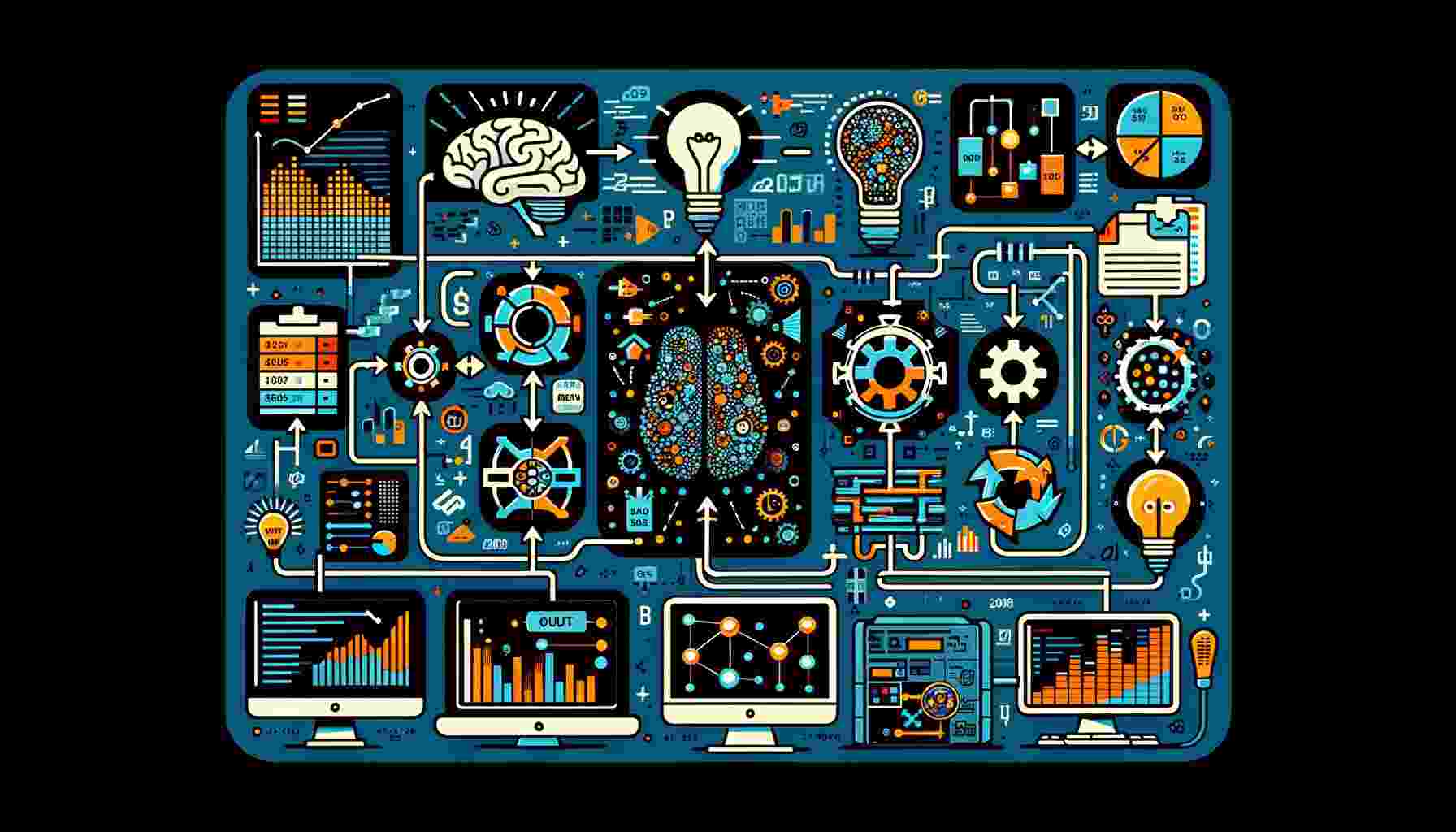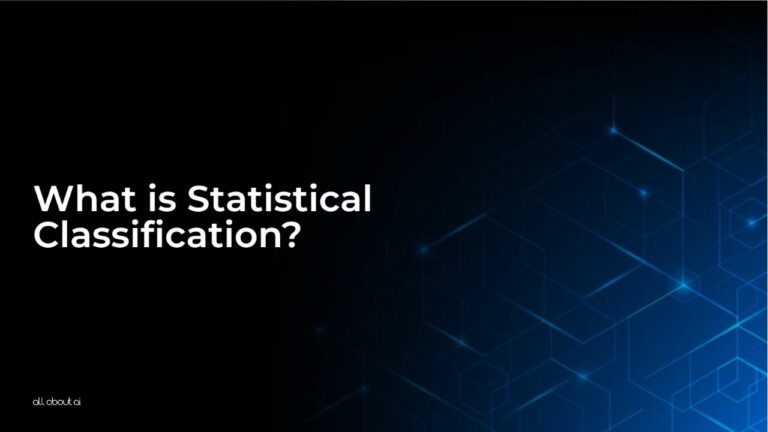Statistical classification stands as a cornerstone in the realm of artificial intelligence (AI), underpinning various applications from spam filtering to medical diagnosis. This process involves categorizing data into predefined classes or groups based on inherent patterns and characteristics.
It’s a fusion of AI, machine learning, and data analysis, where algorithms learn from a training dataset to make predictions or decisions.
Curious about the concept of statistical classification? Keep reading this article penned by the AI savants at All About AI.
What is Statistical Classification? : The Art of Sorting in the AI World!
Statistical classification is like a very important building block in the world of artificial intelligence (AI). It’s used in many different computer programs, like the ones that help figure out which emails are spam (unwanted emails) and even in helping doctors figure out what illness someone might have.
Key Algorithms in Statistical Classification
At the heart of statistical classification are algorithms such as decision trees, support vector machines, and neural networks. Each algorithm has its unique way of processing and interpreting data.
Decision Trees:
Decision trees classify data by creating branches that lead to decision nodes based on the values of the input features. This algorithm is easy to understand and interpret, making it popular for decision-making tasks.
Support Vector Machines (SVM):
SVMs are effective in high-dimensional spaces and are used to find the hyperplane that best separates different classes. They work well for both linear and non-linear classification problems.
Neural Networks:
Neural networks, particularly deep learning models, can model complex patterns in data. They consist of layers of interconnected nodes that can learn intricate relationships in large datasets.
Naive Bayes:
This algorithm is based on applying Bayes’ theorem with the assumption of independence among predictors. Naive Bayes is particularly useful for large datasets and is effective in text classification tasks.
k-Nearest Neighbors (k-NN):
k-NN classifies data based on the majority class of its nearest neighbors. It’s a simple yet effective algorithm for classification tasks where the decision boundary is irregular.
Evaluating Model Performance
Metrics like precision, recall, and F1 score are crucial in assessing model performance.
Accuracy Measurement:
Accuracy is the most straightforward metric, representing the proportion of correctly predicted instances.
Confusion Matrix:
This tool helps visualize the performance of an algorithm. It shows the true positive, false positive, true negative, and false negative predictions.
Precision and Recall:
Precision measures the proportion of positive identifications that were actually correct, while recall measures the proportion of actual positives that were identified correctly.
F1 Score:
The F1 score is the harmonic mean of precision and recall. It is a better measure than accuracy for imbalanced datasets.
ROC-AUC Curve:
The Receiver Operating Characteristic (ROC) curve and the Area Under the Curve (AUC) provide insights into the trade-off between true positive rate and false positive rate.
Training and Validation of Classification Models
The process of model training and model validation involves feeding a dataset into the algorithm, allowing it to learn and make predictions. Here’s a step by step.

- Select a Suitable Algorithm: Choose an algorithm based on the nature and complexity of the data.
- Gather and Prepare Data: Collect data relevant to the problem and preprocess it for training.
- Split Data into Training and Test Sets: Ensure data is divided into separate sets for training and validation.
- Train the Model: Feed the training dataset into the model to allow it to learn from the data.
- Tune Model Parameters: Adjust the model’s parameters to optimize its performance.
- Validate the Model: Use the test set to evaluate the model’s performance on unseen data.
- Iterate as Needed: Refine the model by repeating the process with adjusted parameters or data.
Challenges in Statistical Classification
Statistical classification faces several challenges. Here’s an overview of them.
- Handling Imbalanced Datasets: Achieving accurate classification when one class is significantly more prevalent than others.
- Dealing with Overfitting: Ensuring the model generalizes well to new data, not just the training set, reducing the chances of overfitting.
- High Dimensionality: Managing datasets with a large number of features, which can complicate the model.
- Computational Complexity: Balancing the computational cost with the efficiency and accuracy of the model.
- Data Quality and Preprocessing: Ensuring data is clean, well-preprocessed, and representative of real-world scenarios.
Limitations and Considerations
While powerful, statistical classification has its limitations.
- Bias in Training Data: Biased data can lead to skewed models, affecting the fairness and reliability of predictions.
- Limited Interpretability of Some Models: Complex models like deep neural networks can be difficult to interpret and understand.
- Dependency on Quality and Quantity of Data: The performance of classification models heavily relies on the availability of high-quality and sufficient data.
- Vulnerability to Noise and Outliers: Classification models can be sensitive to noise and outliers in the data, affecting their accuracy.
- Ethical and Privacy Concerns: Ensuring the ethical use of data and maintaining privacy standards is a crucial consideration.
Future of Statistical Classification in AI
The future of statistical classification in AI applications is promising, with advancements in algorithms and an increase in computational power. Emerging trends like deep learning and explainable AI are set to revolutionize how models are trained and interpreted. These advancements hold the potential to enhance the accuracy and application of AI in various domains.

Advancements in Deep Learning:
Ongoing improvements in deep learning algorithms are expected to enhance the capabilities of classification models, especially in complex tasks.
Integration with Other AI Technologies:
Combining statistical classification with technologies like natural language processing and computer vision for more sophisticated applications.
Explainable AI:
There is a growing trend towards developing explainable AI models that are not only accurate but also provide insights into their decision-making processes.
Adaptation to Big Data:
As the volume of data continues to grow, classification and data mining models will need to evolve to handle big data more efficiently.
Ethical AI and Bias Mitigation:
Future developments will likely focus on creating more ethical AI systems that are fair and unbiased, especially in critical applications.
Want to Read More? Explore These AI Glossaries!
Embark on your AI learning path with our detailed glossaries, perfect for everyone from beginners to experts. Make this your preferred guide for expanding your AI insights and discovering its inventive sides.
- What is a Constructed Language?: Often abbreviated as conlang, a constructed language has been artificially created rather than naturally evolved over time.
- What is Contrastive Language Image Pretraining?: It involves training models to understand and generate content by simultaneously learning from language and images.
- What is Controlled Vocabulary?: In artificial intelligence (AI), controlled vocabulary plays a crucial role in enhancing the accuracy and efficiency of data processing and information retrieval systems.
- What is Control Theory?: In the context of artificial intelligence (AI), refers to the systematic design of controllers that manage how AI systems behave in response to external inputs or environmental changes.
- What is Conversational AI?: Conversational AI refers to the application of artificial intelligence in creating systems capable of understanding, processing, and responding to human language in a natural and intuitive way.
FAQs
What is statistical classification theory?
What is the statistical classification approach?
What is the difference between machine learning and statistical classification?
What are the 4 main types of statistical models?
What are the statistical methods of classification of data?
Wrap Up
Statistical classification in AI is a dynamic and evolving field, integral to many modern technologies and applications. By understanding its principles, challenges, and future directions, we can better appreciate its role in shaping the AI landscape.
Looking to learn more about other concepts in the evolving world of AI? Read through the articles we have in our AI Key Terms Index.






